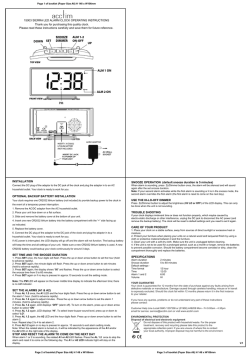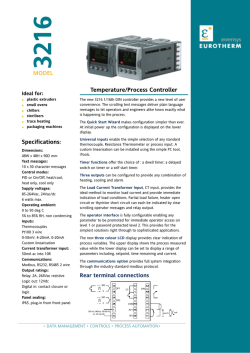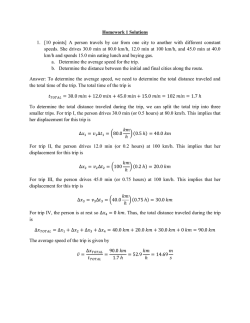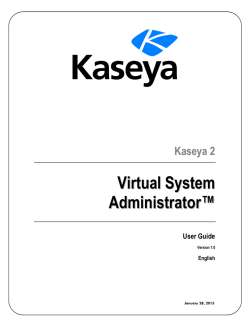
Glossary - The Identiv Academy
Glossary (from the Velocity 3.5 SP1 Online Help) 2-Person Rule This rule provides a high level of security access control for specialized areas, by requiring two authorized persons to be present to enter or exit the secure area. AATL Alarm Active Too Long. This applies to 'non-door' locations that allow an alarm condition to occur for a specified time period before an alarm is actually issued. Doors report DOTL (Door Open Too Long) alarms, rather than AATL alarms. In that situation, an alarm is issued when the door is held open longer than a specified time. Absentee Rule This rule sets the maximum number of days a user may be absent, and therefore not have used their ID to enter a secure area or perform a control function. When the maximum number of absent days is reached, the user is disabled (or optionally deleted). ACBs Alarm Control Blocks are how Hirsch DIGI*TRAC systems create if-then alarm-initiated control sequences. ACBs support the ability to trigger a control zone when the alarm condition is removed (secured), as well as when the alarm occurs. Add-ins Optional features or subprograms added to the basic Velocity program using the Add-In Manager. Alarm Control Blocks See ACBs. alarm levels Settings that determine which alarms designated operators can acknowledge. For example, if an operator is able to acknowledge alarms with a level of 10 or less, then any alarm that is designated as being 11 or above cannot be acknowledged by that operator. alarm queue A list of alarms requiring the operator's attention. In the Badge & Graphic Designer, there is an Alarm Queue pane that displays a list of alarms and their current status. Alarm Stacking If this feature is enabled on the Alarm Options preferences page, the same device can issue more than one alarm. For example, if Expansion Input 3 on Controller 2 triggers Page 1 of 15 Glossary an alarm at 2:01 AM, it is displayed in the Alarm Viewer. Subsequently, it can issue a second alarm at 2:03 without overwriting the first alarm, then issue a third alarm without overwriting the first or second alarms. All three alarms can appear together in the Alarm Viewer. To distinguish between them, you can view either the Count or Time columns. alert When a person is alerted, they are signalled by beeps or a tone whenever they enter a secure area or use their code at a keypad location, to alert the person to their special alert condition. backdrops Drawings created using the Badge & Graphics Designer that are not badges. These can include maps used within the Graphics module, background designs (such as company logos, icons, and emblems) used on badges, or drawings required by Security for other purposes such as bulletins or notices. badgeholders In Velocity, these are known simply as people or persons. Anyone who holds a card or code is an enrolled person. balloon text Text that appears when the cursor hovers over an icon or hyperlink on the screen. Usually a balloon or box appears with some brief explanatory text describing the item under the cursor. In Velocity, this is referred to as a Tool Tip. blueprints Architectural designs for a building or part of the building. Electronic versions of these designs can be imported into the Badge & Graphic Designer for use as maps. bundled Describes a door that incorporates at least one associated relay, input, and reader (usually an entry reader). In Velocity, bundled doors are indicated by a checked box to the left of the item. CAC Common Access Card, a U.S. military identification card. Canvas The pane in the Badge & Graphic Designer where a drawing is actually made. cardholder A person in the Velocity system who is assigned a credential specifying the use of a card. Page 2 of 15 Glossary CCOTZ A variant of COTZ. See COTZ. click Refers to the act of pointing the mouse cursor at an object on the screen, and then pressing and releasing the left mouse button. If you press the right mouse button, this is called 'right-clicking.' code See PIN. code holder A person in the Velocity system who is assigned a credential specifying a code. Code Tamper The act of entering an invalid or incorrect code multiple times. Normally after three attempts, an alarm is issued. concatenate To hash or combine a set of numbers or values to create a new number or value. Control Delay Timer A Control Delay Timer can be set to delay the actuation of a control relay for special control applications. The relay actuation can be delayed for 1-8100 seconds after a valid Control ID entry, or after a relay has been triggered by a Time Zone, or by an alarm or relay triggering a Control Zone. Control Zone Control Zones link a Time Zone to an input, relay, or reader. Control Zones determine where (which door relays, control relays, alarm inputs, and readers) and when (during what hours and on which days) control functions are authorized for a user or user group. There are two types of control zones: standard and master. controller Also called a panel. The electronic device to which all security devices such as inputs, readers, keypad, and relays are connected. The controller is connected via an internally-mounted SNIB to a host PC or XBox. COTZ (Sometimes also called CCOTZ.) Card/Code Only Time Zone. During a specified time zone, the user can use either the card or code (even at a dual technology access point). Page 3 of 15 Glossary Credential Management Known as User Management in the context of the DIGI*TRAC language, this term encompasses a group of tasks that enable Velocity to control how many people enter or exit a specified area. These tasks include day, use, and absentee limits, as well as 2person rule and occupancy settings. credentials Codes or cards assigned to people using the Enrollment Manager. A person within the system can possess more than one credential. CSN Card Select Number. A number that identifies the type of smart card being used and is normally stored in the card's memory. Day Limiting Also called temporary days, this sets a maximum number of days an authorized credential can access an assigned area before access privileges are withdrawn. See also Temporary Day. DESFire Data Encryption Standard Fast, Innovative, Reliable and Secure. This is a contactless smart card technology that employs Triple-DES (Data Encryption Standard), an encryption scheme that provides a high level of security. DIGI*TRAC The Hirsch line of controllers. DIGI*TRAC Command Language The language used to program and talk with Hirsch controllers. This is a large and flexible language, providing hundreds of commands that can implement almost any procedure a security system might encounter. dock Anchoring a screen as a dependency within another window's workspace. For example, if you dock the Event Viewer within the Velocity main window, you cannot drag the Event Viewer outside the confines of the Velocity work space. domain A group of computers and devices on a network that are administered as a unit with common rules and procedures. Within the Internet, domains are defined by the IP address. All devices sharing a common part of the IP address are said to be in the same domain. Page 4 of 15 Glossary domain controller A Windows server with a copy of the Active Directory database, enabling it to support client/server authentication. Door Delay Timer For special entrance or exit control applications, the door timer can be delayed from starting after a granted code, RQE, or time zone actuation. This is especially useful for implementing delayed egress control on emergency exit doors, where local building codes permit such controls to be installed. Door Groups Two or more doors associated with a time zone. Door Groups answer the questions When and Where. The When is the Time Zone, and the Where is the door (Reader). This replaces the old Velocity access zone concept. Several door groups can be defined as a Master Door Group. DOTL Door Open Too Long. An interval beyond that allowed by the parameters of the system for the door to remain open. dragging The act of using a mouse to move an object from one place on the screen to another. Normally this is done by selecting the object with the left mouse button, then pulling the object to another location while continuing to depress the mouse button. At the destination, release the left mouse button to place the object. dropping The act of placing an object at a particular location, usually by releasing the left mouse button. It is associated with the concept of dragging-and-dropping, where an object is selected, moved (dragged), and finally placed (dropped) at a new location. Duress Digit If a qualified person is being forced to open a door against his/her will, the person can indicate this coercion by entering an extra 'duress' digit. By entering this digit, the controller permits access while issuing a silent alarm, immediately alerting the Velocity operator to the situation. enter This term means to type characters using your computer keyboard. It also refers to the Enter key on your keyboard that is most often used to execute a specific procedure. Pressing the Enter key often serves the same purpose as clicking the OK button with the mouse. Page 5 of 15 Glossary Executive Override The granting of privileges specifying that passback limitations don't apply to this credential or person. No passback violation messages will be issued and an accessgrant always works. FASCN Federal Agency Smart Credential Number, as defined in the Federal Information Processing Standard 201 (FIPS201). FIPS201 Federal Information Processing Standard 201, which defines smart cards for federal employees. float Allow a window to go wherever you drag it, whether that is inside or outside the main Velocity window. forgive In the context of security access, the act of overlooking all current passback and occupancy restrictions in the interests of a speedy exit from an endangered area during an emergency. FRAC First Responder Authentication Card. An identity card for emergency scene first responders, such as police officers, firefighters, and medical personnel. function groups Function templates predefined through the Function Group option that can be applied to credentials. Like credential templates or operator groups, function groups provide administrators and qualified operators with a quicker way to apply many functions to a credential. global In the context of Velocity, it refers to the program's ability to share values amongst a large number of controllers if they are connected to the same XBox. Globalizing a value indicates that the value will be recognized by any controller to which the XBox and the Velocity host is connected. GUID Global Unique Identifier is a special type of identifier used in software applications to provide a unique reference number. The value is represented as a 32-character hexadecimal string, such as 21EC2020-3AEA-1069-A2DD-08002B30309D, and is usually stored as a 128-bit integer. The term GUID usually refers to Microsoft's implementation of the Universally Unique Identifier (UUID) standard. Page 6 of 15 Glossary Holiday schedules Groups of holidays. Velocity supports four Holiday schedules. Holidays Days during the year when special rules (access and control) apply. These normally include Christmas, New Years, and July 4th. Velocity groups holidays into Holiday schedules. hot keys Keys that can be pressed to quickly open or close a program or feature (instead of navigating a menu hierarchy). These shortcuts enable operators to work within Velocity more efficiently and more quickly. HTML Hypertext Markup Language. The language used to create World Wide Web pages, with hyperlinks and markup for text formatting (different heading styles, bold, italic, numbered lists, insertion of images, etc.). icon The Velocity term for the point (alarm or relay) or door placed on a map. Each type is represented by a different icon. Icons on a map are linked to the point or door represented. IDK Interoperability Development Kit. interoperable A word describing systems or applications that can communicate or work with each other. IP address The Internet Protocol address; a numeric address such as 123.231.32.2 that the domain name server translates into a domain name. keypads Any device that possesses keys and can be used for entering a code. The most common keypad used with Velocity is a ScramblePad; however, other types of keypads can be used if they conform to MATCH standards. mask Disable for a specified period. In security parlance, it is interchangeable with the disarm. See also unmask. Page 7 of 15 Glossary Master Control Zones Master Control Zones (MCZs) are a compilation of standard control zones. Using MCZs, a qualified operator can create sophisticated control routines that can be triggered by either a single control code entered at any authorized ScramblePad/MATCH reader or a line module input or relay. Master Time Zones Two or more standard time zones. These can be assigned to door groups, function groups, credentials, or many other components within the Velocity system. MATCH The MATCH (Multiple Access Technology Control by Hirsch) board enables a variety of readers and keypads to communicate with Hirsch controllers. No reader or keypad can communicate with a controller without going through a MATCH board. Several ScramblePads, including the DS47L and the ScrambleProx DS47L-SPX, incorporate MATCH boards. MATCH2 A later version of MATCH with a second DIP switch bank that enables configuration of additional reader protocols such as the Corporate 1000. modules Programs that are part of the Velocity software suite. These include Event Viewer, Alarm Viewer, Badge & Graphic Designer, Customization Manager, and the Administration window. mouse button Most mice for Windows possess two buttons: a left button that 'clicks' or causes a particular procedure to occur, and the right button that 'right-clicks' or causes additional options to appear on the screen. mouse rollover A motion that causes text to appear when the cursor hovers over an icon or hyperlink on the screen. Usually a balloon or box appears with some brief explanatory text describing the item under the cursor. MSDE MSDE (Microsoft Data Engine) is an older data engine which has been superseded in Velocity 3.5 by SQL Server 2008 Express. NIST National Institute of Standards and Technology. The government entity responsible for overseeing various standards, including Smart Card standards. Page 8 of 15 Glossary occupancy This provides control over how many people occupy the secure area at any one time. The system counts both the number entering and the number exiting. A running total is kept and whenever the total exceeds the maximum allowed or equals the minimum allowed, access is denied and an occupancy violation alarm is recorded. In addition, the occupancy count can be used to trigger a control zone for automatic masking and unmasking of the protected area, and to change 2-Person Rule to 1-Person Rule when the area is occupied by the minimum required number of persons. OLE Object Linking and Embedding. A compound document technology based on the Component Object Model (COM). OLE allows an object such as a spreadsheet or video clip to be embedded into a document, called the container application. When the object is double-clicked, the application that created it (called the server application) is launched to edit it. operator groups See roles. operators Persons qualified to access and use Velocity. Operators are defined and maintained through the Administration module. Organization Units (OUs) A term used within Windows Active Directory that defines structures within an organization, such as Human Resources or Research, and enables a company to partition employees and the computers they use by the activities that they perform. partitioning The act of dividing processes or persons into groups that can be viewed by only some operators. This is achieved in Velocity through roles, which can include or exclude particular Velocity physical access devices or logical applications, such as person groups or credential templates, from the view of certain operators. passback This requires users to pass through an entry reader and later through an exit reader, before their ID can be accepted at another designated entry reader. Passback is used to reduce multiple entries on a single ID by different persons (ID sharing by passing the card back to another person) and tailgating (more than one person entering on the single use of an ID). It also enables the system to track and report on who is inside the secure area. people Card and code holders for this system. They are enrolled through the Enrollment Manager and are assigned credentials. They are distinguished from operators who have access to Velocity. See also persons. Page 9 of 15 Glossary permissions Permissions are those privileges assigned to operators. Permissions are assigned through roles. person group A feature within Enrollment Manager that enables the administrator to group enrolled users for easier searching and more logical arrangement. person templates Templates incorporating pre-defined values for Personal Information panes. In this way, people can be enrolled more quickly. persons Employees, contractors, or other people who have been granted credentials. This term is used within the Enrollment Manager module. See also people. pick Clicking with the left mouse button on an object to highlight it within the Badge Designer's drawing board. When picked, the object's handles appear. PIN Personal Identification Number. Also called a code. PIV Personal Identity Verification: a standard devised by NIST to regulate the development of smart cards for federal employees. This includes all cards that conform to the DESFire FIPS201 standard. PIV cards contain fields such as Agency Code, System Code, and Credential Number which make up portions of the Federal Agency Smart Credential Number (FASCN). PIV-I PIV-Interoperable: a standard for personal identity verification smart cards that are not issued by federal agencies, but can interoperate with federal PIV systems, and are issued in a manner that enables the federal government to trust the card. For example, PIV-I cards require a specific identity verification process and must include a photograph, fingerprint information, and an Authentication Digital Public Key Infrastructure (PKI) certificate. Examples of PIV-I cards include the First Responder Authentication Credential (FRAC) and the Transportation Worker Identity Credential (TWIC). Page 10 of 15 Glossary PIV reader A smart card reader developed to conform with U.S. government NIST standard for smart card readers. This includes all SmartCard readers that conform to the DESFire FIPS201 standard. populate To place objects or definitions within a particular space. In the context of the Badge & Graphic Designer, it refers to placing devices on an existing map. Within a dialog box, it refers to entering or selecting values for the required fields. press The act of pressing keys on your computer keyboard. For example, to press Ctrl + F8 means to press and hold down the Ctrl key and then press the F8 key on your keyboard. retrigger To trigger again after an initial trigger is over. For example, a RQE can be set to trigger a relay only once, unless it is set to retrigger the relay for as long as it is actuated, such as when using a motion sensor for automatic RQE activation. Return To Normal (RTN) A signal issued by a connected device indicating that a non-normal state previously detected has been rectified and has returned to its normal, expected state. rights Rights are privileges assigned to roles. roles The permissions and rights that can be assigned to a specific person or operator. This takes the place of the old operator groups feature, and enables the administrator to partition access down to the feature and event level. RQE Request to Enter button. Normally this button must be pressed to gain access to or exit from a restricted area. RSS RSS technology is used to create a list of headlines that can be delivered to you. For example, when you report new alarms on a site that supports RSS, those alarms can be added to a feed that a specified operator or administrator subscribes to. RSS feeds enable a specified operator to get update notifications delivered directly to their desktop through a third-party news aggregator program. Page 11 of 15 Glossary scaling Changing the size of an object without distorting the shape of the object. Normally this is accomplished in the Badge & Graphic Designer by holding the object at one of its corner handles and pulling. ScramblePads Hirsch keypads containing the scrambling digit feature. For more about this, see Readers and Keypads - Introduction. ScrambleProx A ScramblePad with a proximity reader built in. screen The frame within which a program or subprogram appears. Used interchangeably with window. serial port A port that uses a serial (sequential) protocol, such as RS-232 or RS-485, to pass data between two or more devices. A USB port is a type of serial port because it passes data sequentially. Smart cards Cards with integrated circuitry including a microprocessor and memory. This card is more of a solid-state PC than a dumb card, with capabilities for storing far more information and performing calculations. Velocity conforms to the FIPS201 federal standard. SNET SCRAMBLE*NET, a network which uses the proprietary Hirsch Encrypted Standard (HES) protocol . This network protocol provides communication between the Hirsch controller and any one of several devices including host PCs. SNIB S*NET Interface Board. This board must be installed in a controller before it can communicate with a host PC. SNIB2 An updated version of the SNIB board, which provides high-speed TCP/IP Ethernet connection between a controller and a networked Velocity server. The SNIB2 can be assigned a unique IP address, enabling remote controllers to be accessed from a networked server. Page 12 of 15 Glossary SQL Structured Query Language. A database query and programming language originally developed by IBM for mainframe computers. It is widely used for accessing data, querying, updating, and managing relational database systems. There is an ANSIstandard SQL definition for all computer systems. Standard Control Zones Standard Control Zones (SCZs) link a time zone with any combination of available relays for output control, or inputs for alarm control. In this way, a SCZ can be used to designate when and which input can be masked, or when and which relay can be controlled. SCZs are only used by Velocity when they are grouped together into Master Control Zones. T-SQL The standard language for communicating between applications and SQL Server. The Transact-SQL language is an enhancement to Structured Query Language (SQL), the ANSI-standard relational database language. It provides a comprehensive language for defining tables; inserting, updating, or deleting information stored in tables; and for controlling access to data in those tables. Extensions such as stored procedures make Transact-SQL a full programming language. table A SQL Server object in a database, which stores data as a collection of rows and columns. tagging When a person is tagged, a tag alert report is printed on the system management printer whenever that person enters a secure area. TCP/IP Transmission Control Protocol (TCP) on top of the Internet Protocol (IP). These protocols enable communication between different types of computers and computer networks. The Internet Protocol is a protocol which provides packet routing. TCP provides reliable communication and multiplexing. Temporary Day This feature specifies which days of the current week and the next week the user will be authorized. When the last day expires, the user is disabled (or optionally deleted). threat level A numeric value assigned to each card reader. For access to be granted at a card reader, the reader checks the threat level of the badgeholder’s card against the reader's own threat level, then against the system's threat level. If the card threat level is greater than or equal to both the reader's and the system's threat level, access is granted. If the card threat level is less than either, access is denied. Cardholders with executive privilege enabled are exempt from the threat level criteria. Changing the Page 13 of 15 Glossary system's threat level can act to either grant or deny access to all the doors in the facility. The greater the number, the greater the threat level. Also called threat authority. Time Zones Time Zones are one of the most basic units of Velocity configuration. They indicate when something happens, including time and day of week. token A token is a component of an event that is included when the event is broadcast. Most events include more than a dozen tokens that specify such features of the event as the date and time, the event ID, the source of the event, the controller and door where the event happened, and numerous other aspects of the event. Tool Tip text Text that appears in a box or balloon when your cursor hovers over an icon or hyperlink. This text usually explains the item in a little more detail. trigger A stored procedure that executes when data in a specified table is modified. Triggers are often created to enforce referential integrity or consistency among logically related data in different tables. For example, an RQE input can be set to trigger a relay for use with magnetic locks. The RQE will trigger the relay only once, unless it is set to retrigger the relay for as long as it is activated, such as when using a motion sensor for automatic RQE activation. See also retrigger. TWIC Transportation Worker Identification Credential. unbundle Disassociate the parts of a door. The relays, inputs, and readers associated with a door are unassigned so that they can be used for other purposes. See also bundled. unmask To arm or rearm a device. To enable and allow the input to talk with the controller. The opposite of this is to disarm or mask. See also mask. use count This sets a maximum number of times an authorized user can use their ID to enter a secure area or perform a control function. Up to a maximum of 31 uses can be allowed. When the use count expires, the user is disabled (or optionally deleted). Page 14 of 15 Glossary users This term is rarely used in Velocity because it is too ambiguous: it can refer to either people (such as employees or contract workers) who use the system, or operators who manage and oversee the system. For this reason, refer to either people or persons for the first type, and operators for the second type. view An alternate way of looking at SQL Server data from one or more tables in the database. A view is a virtual SQL Server table, usually created as a subset of columns from one or more tables. XBox The SCRAMBLE*NET Gateway (XBox). It provides a high-speed gateway from a Host PC to a network of DIGI*TRAC controllers. The XBox can support up to 63 DIGI*TRAC Controllers through a single XBox, and is required to form an XNET network. XML Extensible Markup Language. A subset of the Standardized General Markup Language (SGML). XNET All Velocity systems using an XBox as one of the components. The XNET protocol can generally support a larger network of controllers than SNET. Page 15 of 15
© Copyright 2026






